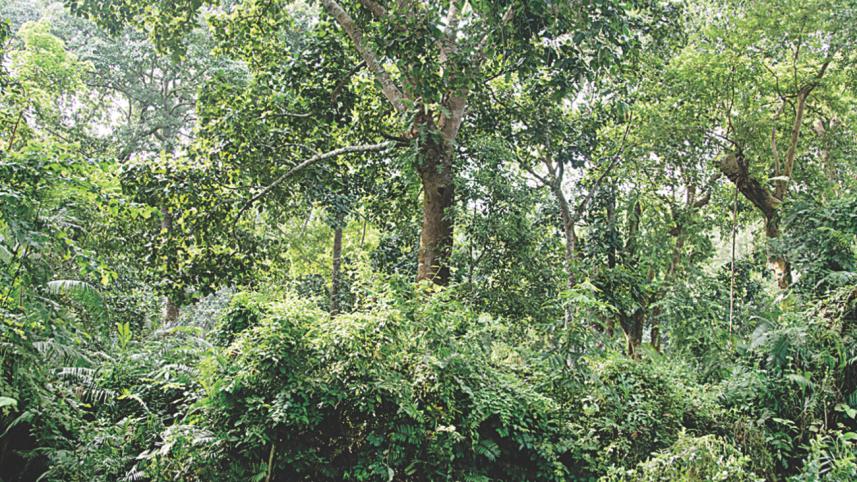Shatchori Morning

In the past I visited Shatchori National Park only during winter, but today I have the opportunity to experience it in a different season. At the tail end of a prolonged monsoon, I am hoping to see the rich, dense greens that the rains have created.
Entering the park, I climb up on the watchtower and take in a panoramic view of the canopy. A thin mist arises in the morning light from the denser patches. Occasionally a bamboo or two shoot over their neighbours, the pointed yellow leaves punctuating the otherwise bare thin trunk. My eyes drink in the vivid, primeval green.
The attractions of Shatchori compete for my attention. The trees, of course, are magnificent anytime, but now they have found new life after the rains. They also offer another dimension: many of the trees I see in or near the towns, or by the side of the road, such as jarul and mandaar, are not very old. In an old forest like Shatchori I can see what these same trees look like when they have been allowed to grow unrestrained for many decades. A spiny mandaar, for example, in most places is hardly more than ten feet tall and six inches in girth. But in Shatchori it is huge – perhaps thirty feet tall and 2-3 feet in girth. Observing this makes my mind wander: I try to imagine the kind of primeval forest that once covered the hills of Sylhet.
But today the birds compete with the trees for my time. In the undergrowth are little ones such as the puff-throated babbler which can balloon its throat to frighten predators. Up in a tall chapalish tree is a beautiful blue velvet-fronted nuthatch scouring the branches for insects. On a horizontal branch of a hingra tree are three chestnut-headed bee-eaters. They only eat flying insects which they catch with their pointed beaks. One of them sallies forth and returns to the perch with insect in mouth while the second is still scanning the air for its meal. The third gets nervous at my approach and, after fidgeting for a few seconds, takes off for a spot farther away.
After hiking for three hours my time in the Park is over. On the way out I stop at a tube-well near an ethnic village of Tripura people. The water is cold and sweet. Just as I am about the exit the park, I see movement on top of a tall tree. A family of capped langur (poramukho honuman) is eating the fruits and, literally, hanging out on the tree. They ignore me and my camera.
Shatchori National Park is a 600-acre reserve forest in Habiganj district, about 130 km from Dhaka. It is relatively compact and has the usual long, medium and short hiking trails that one finds in our national parks. Its name comes from seven streams which run through it. Before it was made a national park in 2005, it was part of the Raghunandan Hills Range of the forest department.
From Dhaka, it takes three to four hours to reach Shatchori, depending on traffic. If you go, I recommend hiring a knowledgeable guide who can enrich your tour significantly.
facebook.com/tangents.ikabir



 For all latest news, follow The Daily Star's Google News channel.
For all latest news, follow The Daily Star's Google News channel.
Comments